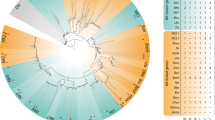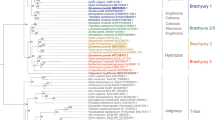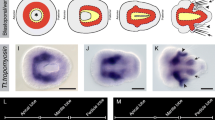Abstract.
The T-Box transcription factor Brachyury plays important roles in the development of all bilateral animals examined so far. In order to understand the ancestral function of Brachyury we cloned NemBra1, a Brachyury homolog from the anthozoan sea anemone Nematostella vectensis. Anthozoa are considered the basal group among the Cnidaria. First NemBra1 expression could be detected at the blastula/gastrula transition and gene activity persists until adulthood of the animals. In situ hybridization shows that NemBra1 expression in gastrulae and early planula larvae is restricted to a circle around the blastopore. When the larvae begin to metamorphose into primary polyps, the expression zone extends into the developing mesenteries. In adult polyps Brachyury expression persists in the mesenteries, but is excluded from the septal filament and the differentiated retractor muscles, which also develop from the mesenteries. We conclude that the ancestral function of Brachyury was in specifying the blastopore and its endodermal derivatives.
Similar content being viewed by others
Author information
Authors and Affiliations
Additional information
Electronic Publication
Rights and permissions
About this article
Cite this article
Scholz, C.B., Technau, U. The ancestral role of Brachyury: expression of NemBra1 in the basal cnidarian Nematostella vectensis (Anthozoa). Dev Genes Evol 212, 563–570 (2003). https://doi.org/10.1007/s00427-002-0272-x
Received:
Accepted:
Issue Date:
DOI: https://doi.org/10.1007/s00427-002-0272-x




